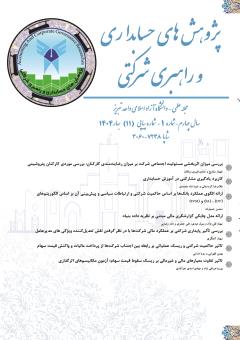تاثیر تفاوت معیارهای مالی و غیرمالی بر ریسک سقوط قیمت سهام؛ آزمون مکانیسمهای اثرگذاری
محورهای موضوعی : شفافیت مالی و بازار سرمایه
پوریا صرافی نژاد
1
![]() ,
مهدی اسدی جوآبادی
2
,
مهدی اسدی جوآبادی
2
![]()
1 - گروه مدیریت مالی، دانشگاه امام صادق(ع)، تهران، ایران.
2 - گروه مدیریت مالی، دانشگاه امام صادق(ع)، تهران، ایران.
کلید واژه: ریسک سقوط قیمت سهام, تفاوت معیارهای مالی و غیرمالی, تقلب مالی, دستکاری فعالیت های واقعی,
چکیده مقاله :
هدف این پژوهش ارزیابی تاثیر تفاوت معیارهای مالی و غیرمالی بر ریسک سقوط قیمت سهام است. بعلاوه مکانیسمهای این اثرگذاری با در نظر گرفتن نقش میانجی تقلب مالی و دستکاری فعالیتهای واقعی نیز ارزیابی شده است. تفاوت معیارهای مالی و غیرمالی به معنای اختلاف و تناقض بین معیارهای مالی عملکرد و معیارهای غیرمالی مرتبط است. بر اساس اطلاعات گردآوری شده از 153 شرکت پذیرفته شده در بورس اوراق بهادار تهران طی سالهای 1394 تا 1402 و با استفاده از تکنیکهای اقتصادسنجی، یافتههای پژوهش نشان داد تفاوت زیاد بین نرخ رشد سود عملیاتی به عنوان معیار مالی و نرخ رشد فروش و نرخ رشد موجودی کالا به عنوان معیارهای غیرمالی، با ریسک سقوط قیمت سهام بالاتر همراه است. همچنین، آزمون مکانیسمهای اثرگذاری نشان داد که تفاوت معیارهای مالی و غیرمالی از طریق افزایش تقلب مالی و دستکاری فعالیتهای واقعی، باعث افزایش ریسک سقوط قیمت سهام میشود. این نتایج میتواند برای تنظیمکنندههای مقررات نظارتی در جهت بهبود شفافیت گزارشگری مالی و طراحی مکانیسمهای نظارتی کارآمدتر به منظور کاهش انگیزههای دستکاری و تقلب مفید باشد.
The aim of this research is to evaluate the impact of differences between financial and non-financial metrics on stock price crash risk. Additionally, the mechanisms of this influence have been assessed considering the mediating role of financial fraud and real activity manipulation. The difference between financial and non-financial metrics refers to the discrepancies and contradictions between financial performance metrics and related non-financial metrics. Based on data collected from 153 firms listed on the Tehran Stock Exchange from 2015 to 2023, and using econometric techniques, the findings of the study indicate that a significant discrepancy between the growth rate of operating profit as a financial metric and the growth rates of sales and inventory as non-financial metrics is associated with a higher risk of stock price crashes. Furthermore, testing the mechanisms of influence revealed that the differences in financial and non-financial metrics increase stock price crash risk through heightened financial fraud and manipulation of real activities. These results may be beneficial for regulatory authorities in enhancing the transparency of financial reporting and designing more effective regulatory mechanisms to reduce incentives for manipulation and fraud.
امیرمعزی، حسین؛ پورآقاجان، عباسعلی؛ و جعفری, علی. (1403). کشف تقلب صورتهای مالی: قیاس توانایی مدلهای مبتنی بر متغیرهای حسابداری. دانش حسابداری و حسابرسی مدیریت، 13(52)، 173-188.
برادران حسن زاده، رسول؛ و حشمت، نسا. (1398). بررسی تاثیر متمایز انحراف از فعالیتهای واقعی و مدیریت واقعی سود در خطر سقوط قیمت سهام. مدیریت دارایی و تامین مالی، 7(2/25)، 81-98.
Amirmoezzi, H., Poraghajan, A. & Jafari, A. (2024). Detecting Financial Statement Fraud: Comparing the Ability of Models Based on Accounting Variables. Journal of Management Accounting and Auditing Knowledge, 13(52), 173-188. (in persian)
Baradaran Hasanzadeh, R. & Heshmat, N. (2019). Studying the Distinct Impact of Abnormal Real Operations and Real Earnings Management on the Subsequent Crash Risk in Stock Prices. Journal of Asset Management and Financing, 7(2), 81-98. (in persian)
Behn, B. K., & Riley, R. A. (1999). Using nonfinancial information to predict financial performance: The case of the U.S. airline industry. Journal of Accounting, Auditing & Finance, 14(1), 29–56.
Brazel, J., Jones, K., & Zimbelman, M. (2009). Using nonfinancial measures to assess fraud risk. Journal of Accounting Research, 47(5), 1135–1166.
Dechow, P. M., Ge, W., Larson, C. R., & Sloan, R. G. (2011). Predicting material accounting misstatements. Contemporary Accounting Research, 28(1), 17–82.
Habib, A., Hasan, M. M., & Jiang, H. (2018). Stock price crash risk: Review of the empirical literature. Accounting & Finance, 58, 211–251.
Ittner, C. D., & Larcker, D. F. (1998). Are nonfinancial measures leading indicators of financial performance? An analysis of customer satisfaction. Journal of Accounting Research, 36, 1–35.
Jin, L., & Myers, S. C. (2006). R² around the world: new theory and new tests. Journal of Financial Economics, 79(2), 257–292.
Khurana, I. K., Pereira, R., & Zhang, E. (2017). Are real earnings smoothing harmful? Evidence from firm-specific stock price crash risk. Contemporary Accounting Research, 35(1), 558–587.
Kim, J. B., & Zhang, L. (2016). Accounting conservatism and stock price crash risk: Firm-level evidence. Contemporary Accounting Research, 33(1), 412–441.
Kim, J. B., Wang, Z., & Zhang, L. D. (2016). CEO overconfidence and stock price crash risk. Contemporary Accounting Research, 33(4), 1720–1749.
Kong, D., Shi, L., & Zhang, F. (2021). Explain or conceal? Causal language intensity in annual reports and stock price crash risk. Economic Modelling, 94, 715–725.
Loureiro, G., & Silva, S. (2022). Earnings management and stock price crashes post U.S. cross-delistings. International Review of Financial Analysis, 82, 102215.
Wei, L., & Zhang, Y. (2023). Nonfinancial indicators in identifying stock price crash risk. Finance Research Letters, 52, 103513.


